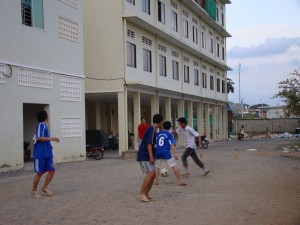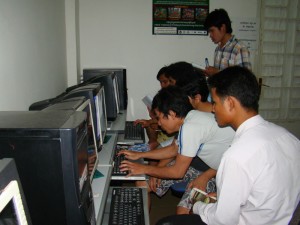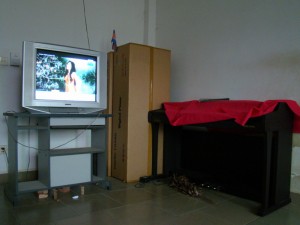Cue: Water is important for organ. However, there is about 42 percent of Cambodia living in rural area can access to clean water, according to censors’ Ministry of planning in 2008. Besides, rural people still continue using contaminated water and Arsenic water, which mostly can be seen in water well. Dara Saoyuth Report
Intro: For those living in the city or urban area, they are able to access to clean water while most of the people living in countryside still continue using water getting from other sources including water well, river , rain water and others.
Track1: Mao Saray, director of the department of Rural Water Supply said, most of rural area people have limited knowledge in using clean water.
Clip1: The thing is that our residents have low knowledge of clean water, they don’t know what is clean water, how to use clean water, and what is the advantages of using it. Having low knowledge of clean water is the main problem, so we have to solve this problem first
Track 2: The government and NGOs have educated people how to use clean water for daily life. The organizations like IDE, RDI and UNICEF have produced some water treatment filter to distribute and sell to the people in the purpose of giving clean water to people.
Track3: Loy Chantry, sale and marketing manager of Rabbit water filter of IDE organization says that his water filter can treat the virus up to 99.99 percent because it is made by baking clay and is painted with silver substance for filtering micro virus.
Track4: However, some people have not used water filter yet and they keep drinking uncooked water that Loy Chantrea gives reason:
Clip2: Most of the people are obstinate. They think that rain water is the clean water and they have never had any disease. The drinkable water is boiling and filtering water.
Track 5: Simultaneously, the arsenic water is the main concern for people living along Mekong River as they believe in using ground water.
Track 6: Notably that arsenic substance in water was found in Cambodia 2001. Arsenic is the chemical substance stemming from nature. It is in the water, land, air, rock, plant and animals. When people absorb it from 3 to 10 years, they can get the diseases including thickening and discoloration of the skin, stomach pain, nausea, vomiting, diarrhea, numbness in hands and feet, blindness and it can lead to other cancers.
Track7: According to the study on tube well of the Ministry of Rural Development and UNICEF, 16000 tube wells in the provinces along Mekong and Bassac rivers, there are 7 provinces whose wells consists of arsenic including Kandal, Prey Veng, Kampong Cham, Kampong Thom, Kampong Chhnang, Pailin and Kratie.
Track8: Travelling from Kampong Sabu station to Prek Russey in Kandal provincial Koh Thom district’s Kampong Kong commune where around 200 people are affected by arsenic. They drink arsenic water without knowing for more than 10 years.
Track 9: Chhai Ly Sokha has two brothers die of cancer due to arsenic substance. Nowadays, she and her family of 3 members are being with arsenic disease.
Clip3: I am feel that I regret drinking that water at that time because it is said that the ground water is sanitary and then I just drink it, but now it is over time because I have that disease already.
Track10: Nowadays, Chhai Ly Sokha’s family stopped drinking well water and use river water instead.
Track 11: Chhang Veun, 40, lost his father and his brother in 2010 because they have leg cancer caused by drinking arsenic water. He said that his father and brother’s legs were cut but they cannot live. Now, there are 4 members in his family who have arsenic.
Track12: Due to that fact that arsenic cannot be killed by the boiling water, the arsenic water filtering system was created in 2006 by the Institute of Technology of Cambodia (ITC). Uy Davin, the consultant of Research and Development, tells the advantages of using this system.
Clip4: Besides it can filter the arsenic, it can treat other substances and viruses in order to make our water in the standard of World Health Organization.
Track 13: The system was tested in Prey Veng and Kandal’s Kein Svay for 2 years and Uy Davin says that the system can filter the arsenic 100 percent.
Track 14: However, the system have not yet installed at the arsenic-affected area. Uy Davin says that the system has to spend 2500 to 4000 dollars and the institute practice due to the limited budget.
Clip5: I do it according to the money. When I have money for one village, I will do it for that. They can help us only knowledge, but the people who are poor without water, they still drink the well water and get the disease.
Track15: Uy Davin said that we have to deal with arsenic problem, adding that they cannot provide water to people without charging.
Clip6: We will sell in the appropriate price like 20 to 30 liters, we sell for 100 Riel, 50 Riel of which for system repairing and the rest for the system controllers.
Track 16: Mao Saray says, the ministry of Rural Development is planning to provide clean water to people at least 50 percent in 2015 and 100 percent in 2025.
By: Dara Saoyuth & Vorn Makara Cue by Vorn Makara & Present by Dara Saoyuth 12/01/2010Related Articles
- ការទទួលបានទឹកស្អាតនិងទឹកដែលមានសុវត្ថិភាព នៅកម្ពុជា (http://saoyuth.wordpress.com)









